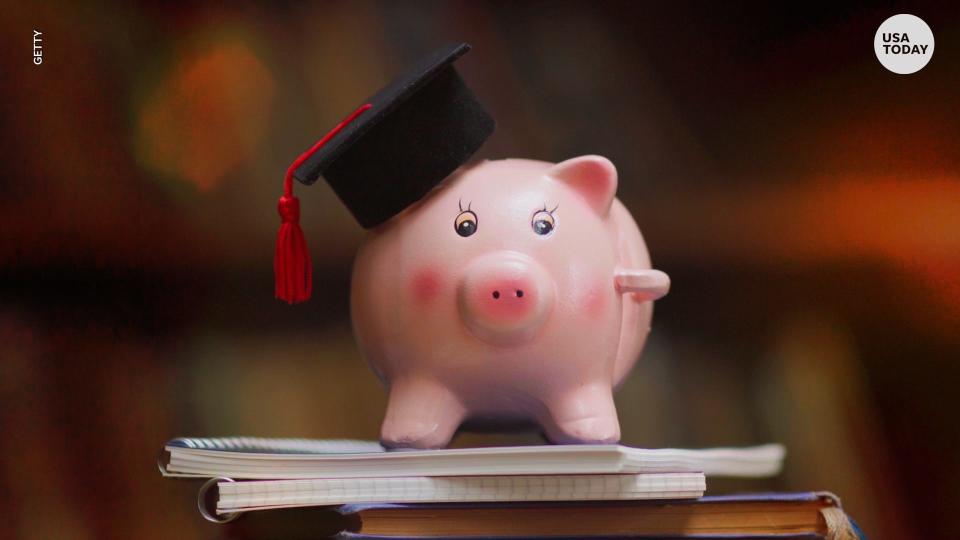Federal student loan repayments start Oct 1. Here's what you need to know
Federal student loan repayments start on Oct. 1, marking the end of a three-year pandemic-era grace period that seemed like it could last forever.
The long reprieve from loan repayment, put in place by the Trump administration and extended by President Biden, is hours away from ending. The freeze on interest rates already ended on September 1. Most borrowers would have already received billing statements with resumed interest payments calculated from September. Plan to start sending in payments on or after October 1.
Here’s a Q&A with comments from loan repayment expert Michael Kitchen, a senior managing editor at online lending clearinghouse, LendingTree.com:
How do I prepare for payments to begin?
If you have not already done so, log in to your loan servicer’s page and update your contact information with any changes, including email and mailing address.
Log in to your servicer’s account. If the bill has been sent, you will see the amount owed. You will see the payment due date, upcoming interest, and payment amount.
Your payment will be due 21 days after you receive the statement.
What if I don't know who my loan servicer is?

Call 1-800-4-FED-AID (1-800-433-3243) or visit and dashboard on https://www.studentaid.gov
Can I set up automatic payments from my bank account?
Yes. Auto pay means your servicer will automatically deduct your monthly payment from your bank account. If you sign up for auto pay, you’ll pay 0.25% less in interest each month. Sign up for auto pay on your loan servicer’s website.
How can I reduce my monthly payment?
If you have not already picked a repayment plan, explore the options offered on the studentaid.gov website. The government offers an Income Driven Repayment plan, or IDR, to tailor your payment according to your disposable income. If you have not picked a plan, apply for one at https://studentaid.gov/idr/
A new plan called "SAVE," available on studentaid.gov and created for the Oct. 1st deadline is much more generous than previous IDRs, said Kitchen of LendingTree. It will reduce the monthly payment for most people compared to what they were paying previously on an Income Driven Repayment plan. And starting next year in October, it will drastically reduce the period that loans are owed, he said.
Consolidating different loans, if you have more than one, is also an option. But while they can reduce your monthly payment, your interest might go up.
Related: Millions plan to use Biden's SAVE student debt relief plan as some in GOP try to stop it
Can I still defer my loan?
You can apply for a temporary pause or lower payment using short-term relief. Use the loan simulator tool to decide how short-term relief affects your monthly payments. Then contact your loan servicer to apply for relief.
It is important to remember that unlike during the COVID-19 emergency, interest can still accrue during the short-term relief period.
What if I miss payments?
If you miss payments, your loan becomes delinquent. But loan servicers will not report delinquent or defaulted loans to the credit bureaus for a whole year as payments resume.
Starting Oct. 1, 2024, servicers will resume reporting delinquent loans to the three major credit bureaus after 90 days. Also starting in October next year, if payments are not made for up to 270 days, the delinquent loan goes into default. This could result in the government taking payments out of your paycheck, your tax refund or your social security benefits.
For already defaulted borrowers, the government is offering a one-time temporary program called the Fresh Start Initiative to return the loans to good standing. The enrollment process takes just 10 minutes, according to studentaid.gov. Learn more at https://studentaid.gov/announcements-events/default-fresh-start.
What happens to my repayment schedule when the government shuts down?
For the most part, unless a shutdown continues for an extended period, there should be no impact on payments, said Kitchen. Direct queries to the federal government's agencies could be delayed, but loan servicers should continue to function.
Colleges: These New Jersey colleges see boosts in 2024 U.S. News rankings
Are federal student loans really forgiven after 20 to 25 years?
All the Income Driven Repayment (IDR) plans end in 20 or 25 years, said Kitchen. "Whatever's left after that is usually forgiven. It's possible you could pay off your loan before that, depending on how much you make. But if you're in a low income profession or a field that isn't eligible for many forgiveness options, you could get a bundle forgiven at the end of the program."
How much would a monthly payment be on a $70,000 student loan?
On a standard repayment plan, payment would be around $724 per month for 10 years at around 5% interest, said Kitchen. Use the federal government's loan simulator tool to estimate your payments.
Are you placed on a repayment plan automatically unless you contact your servicer?
Yes. The standard repayment plan has 10 years of the same payment every month, said Kitchen. To change your repayment plan, contact your loan servicer. Other plans include the Income Driven Repayment plans, the Graduated Repayment plan that starts with small payments that increase over time, and the Extended Repayment plan which is fulfilled over 20 years instead of 10, he said.
Details of loans, including borrower rights and responsibilities are available at https://studentaid.gov/mpn/.
This article originally appeared on NorthJersey.com: Student loan repayment start date is Oct 1. What to know
